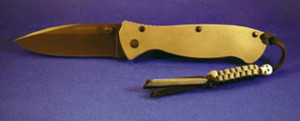Ten Steps to a Tactical Knife
These days, any product that can possibly be associated with self-defense, personal defense, or just plain survival, is being touted as “tactical.” There are tactical holsters, pens, binoculars, flashlights, backpacks, and the list goes on. 
With that in mind, there are many types of knives on the market, but is a butter knife a tactical weapon?
If not, then what makes a knife “tactical?”
Here is a list of pre-requisites to check off before you can claim bragging rights for your blade:
- The design of the knife should meet your specific needs. For a concealed carry last resort weapon, it should be easily accessible and able to open quickly.
- A knife can be tactical in many different situations and a hiker carrying a Swiss Army knife on the Appalachian Trail probably doesn’t think of it as a tactical weapon. But the same knife used by law enforcement to jimmy a lock could then be considered a tactical weapon.
- A true tactical knife should feel like it was personally customized for you. Many knives have curves, swirls, and grooves that do little to improve the functionality of the knife. In addition to the blade feeling good in the closed position, it should feel natural while opening, in the open position, and while closing.
- While a Bowie or German paratrooper knife may look impressive, it does not fit the bill for concealed carry and would likely attract the attention of thieves. A folding knife with an overall length of about 8 inches is appropriate for a backup knife.
- The blade should be made of stainless steel, which most companies are using these days. Avoid any knife made in Pakistan or China. If you can get your hands on a blade made with W1 steel, grab it. It’s the best on the market.
Handles come in many shapes and sizes. Avoid natural materials because they absorb moisture. Polymers are generally reliable, as are metal handles. Pick one you can be comfortable with for many years.
- Blade Design. The basic requirements are a cutting edge and a point. Any good blade should be at least 1/8 inch thick. And make sure your blade is serrated. In a last chance scenario, the blade’s serrations will still cut.
- Folding knives do not have dependable locks. Naturally, the higher the quality, the better the locking mechanism, but never trust any mechanism to hold; it will fail when you need it most. Buy the best knife you can afford.
- Fixed Blade or Folder. This is a personal choice based on individual needs. Both can be tactical in the right situation. The fixed blade is inherently stronger because it has no moving parts, but for concealed carry, a folding knife may be the way to go. However, a folding knife can be harder to access and employ.
- Carry Options. The main rule for knife carry is to put it in the same place all the time. Having to remember where it is when you need is not a situation that will end well for you.
- Buy from a company that will back up its product and is not just selling hype, such as official “SWAT” or “Army Ranger.” Again, you don’t want a knockoff that was made in a foreign country with sub-par materials.
Author Ernest Emerson says it best in his article “Ten Things That Make a Tactical Knife” at USConcealedCarry.com:
“Choose a knife from a reputable manufacturer and purchase it from a reputable dealer. Swap meets are not on that list.” (Read more at USConcealedCarry.com)
